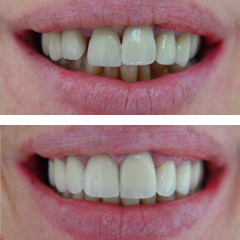 Gap between front teeth or diastema as called, is a controversial issue in smile esthetics.
Gap between front teeth or diastema as called, is a controversial issue in smile esthetics.
A lot of people consider it as part of their style and they wouldn't change it for anything. Lately, we see a lot of fashion editorials with models showing their teeth diastemas. The truth is that beautiful people styled nicely with good lighting and beautiful clothes, can make even the biggest diastemas look good.
Since most of us though are not as good looking, nor styled as nicely as models, we tend to focus on small imperfections that bother us and we often look for an esthetic solution. Teeth diastemas are one of the most common reasons that brings patients in our clinic, proving that people often think of them as a problem and wish to have them closed.
Why are there gaps between front teeth? The most common reasons are:
- Mismatch between small teeth and big jaws
- Labial frenum
- Genetics
- Congenitally missing teeth
- Thumb sucking
- Incorrect swallowing reflex
- Periodontitis
- Combination of the above
Depending on the reason, the size of the gap and its treatment may be different.
Let's see some examples of cases that have been treated in our clinic to understand the options available.

When one or more teeth are missing congenitally, meaning they were never developed, then the gaps between the teeth are usually big. The female patient presented in the picture is having gaps due to congenitally missing lateral incisors.
A simple way to treat a case like that is by changing the shape of the existing teeth in order to resemble the ideal composition. In this case the central incisors were altered in shape with porcelain veneers in order to close the existing gap, while the canines where made to look like the missing laterals. The first premolars were left untreated since their labial side, resembled the shape of canines.
 In other cases when teeth are missing congenitally, gaps are left between teeth, while the existing teeth are moving to the empty space.
In other cases when teeth are missing congenitally, gaps are left between teeth, while the existing teeth are moving to the empty space.
Another way to treat a case like that, is with orthodontics in order to move the teeth to their right place, resulting in a space big enough to fill with a new tooth.
In the case of the picture dental implants where used in the position of the missing lateral incisors after orthodontic treatment.
 When teeth have gaps between them because of periodontitis, then it is necessary before the esthetic improvement of a case to treat the disease first.
When teeth have gaps between them because of periodontitis, then it is necessary before the esthetic improvement of a case to treat the disease first.
In periodontitis often the teeth are moving labially too, so deciding to treat them esthetically involves orthodontic treatment too.
In the case of the picture, teeth had gaps between them due to periodontitis , but changing the existing prosthesis with a new one without orthodontics, resulted in fixing the esthetic problems.
Treatment of diastemas
We as dentists can correct a teeth diastema successfully, but we have to study every case carefully in order to find the right way. A lot of times we need to do a diagnostic wax up first on casts made out of our patients mouth, in order to figure out the best possible treatment.
Gaps between teeth are usually treated by applying some type of restorative material on the teeth adjacent to the gap. The treatment is successful only if the application of the restorative material is done symmetrically in both teeth.


The picture to the left presents a case where we used composite resin to close the gap in only one appointment while on the case of the second picture gaps where closed with porcelain veneers in 3 appointments.
The choice of the restorative material depends mostly on the patient. Dentists present the pros and cons of every material and the patients decide mostly according to the cost and the time needed to finish the treatment.
Orthodontics may be an excellent treatment too, but a lot of patients do not choose a treatment plan that involves it because it needs time and the application of braces.
Orthodontics may be the most suitable treatment for diastema closure when
- Gaps between teeth are big and the teeth next to it have moved in places that do not allow esthetic dentistry.
- Teeth are already wide and the application of restorative material may result in unaesthetic result
- Teeth not only have gaps but they have a labial inclination too.
Do not forget when you discuss the gap closure with your dentist to ask if he/she has treated cases like that before and ask for pictures of the result.
If the esthetics of your smile are very challenging ask your dentist for a mock up of the final result. This can be easily fabricated on a model of your case and will allow you to have a better understanding of the final result. This approach will make you feel safer and will give you the chance to discuss all your concerns and possible changes needed in order to achieve the best possible result.
What do you think? Do you have a gap between your teeth? Do you like it? Have you thought of improving it with esthetic dentistry?
Post's intro picture found here.







